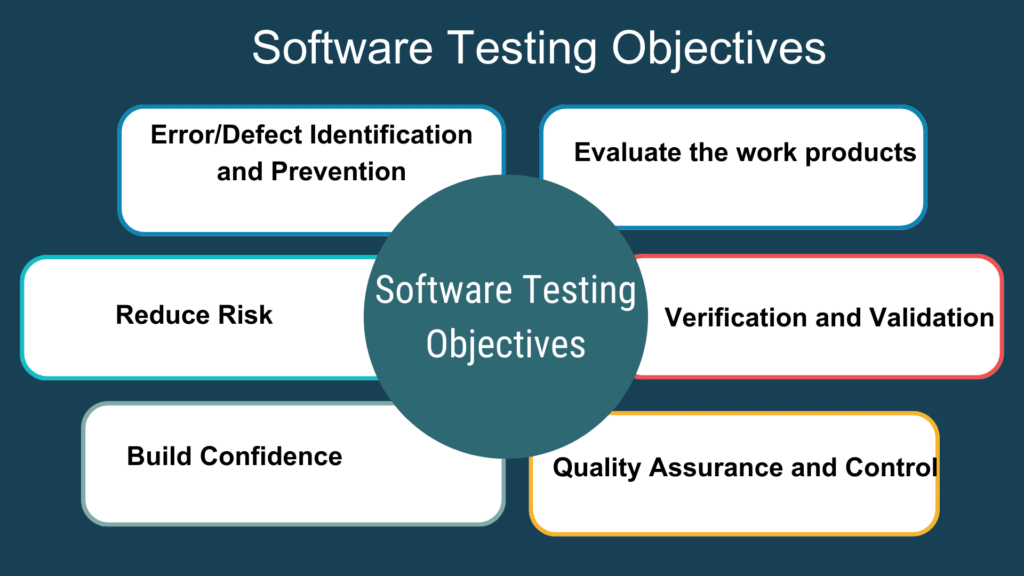In the continually evolving landscape of software development, quality assurance stands as an essential foundation. Crucial for guaranteeing prime functionality, reliability, performance, and security, software testing holds a pivotal position. Yet, underlying these surface aims are deeper objectives that intricately mold the testing process. This article aims to delve into these core Software Testing Objectives, illuminating their profound importance. These objectives play a crucial role in producing resilient and dependable software solutions.
Software Testing Objectives and Principles
The software testing objectives are underpinned by fundamental principles that provide a framework for a systematic and effective testing approach. Additionally, Software Testing Principles provide the framework and methodology for achieving Software Testing Objectives. By adhering to these principles, testers can effectively work towards fulfilling the objectives of software testing. This ultimately contributes to the success of the product.
What Are Software Testing Objectives?
Integral to the software development lifecycle is software testing, ensuring that products meet quality standards. Furthermore, the software testing objectives encompass functionality assessment, defect identification, user satisfaction assurance, and dependable performance validation. These objectives contribute to product success by enhancing quality, reliability, and user experience. Overall, software testing drives the process, encompassing various facets such as functionality, reliability, performance, and security. Additionally, they validate requirements, improve user experience, and maintainability, and mitigate risks. Ultimately, they ensure software meets stakeholder expectations, delivering robust, reliable, and high-quality products.
List of Software Testing Objectives

Error/Defect Identification and Prevention
Software testing aims to identify defects early, facilitating timely rectification and significantly reducing later development cycle costs and efforts for bug fixing. Additionally, prevention strategies, equally important, adopt a proactive testing approach, integrate lessons learned, and continuously refine the testing process to prevent known types of defects from occurring. Moreover, by emphasizing early defect detection, these strategies enable prompt rectification and minimize the impact of issues on the software development cycle to achieve software testing objectives.
Evaluate the work products such as Requirements
Functional testing ensures that software operates as intended and meets defined requirements effectively. It is one of the main software testing objectives. Additionally, simulating user interactions is essential for conducting functional tests successfully. For example, in a ticket booking application, users should seamlessly receive confirmation emails, reserve tickets, and cancel bookings.
Validation and Verification
Software testing relies on validation and verification to ensure products meet user needs and expectations. Verification confirms adherence to requirements, while validation ensures suitability for the intended environment. Both are crucial for exceptional software products, surpassing user expectations. This underscores the significance of thorough testing throughout development to deliver high-quality software that meets user needs effectively.
Quality Assurance and Control
Monitoring and evaluating the various aspects of software development systematically is quality assurance, ensuring that standards of quality are met. In contrast, quality control is a reactive process that focuses on identifying defects in the actual products. So, throughout the development lifecycle, quality assurance and control together form a comprehensive approach to managing software quality to achieve software testing objectives.
User Satisfaction and Experience
Software testing objectives guarantee a favorable user experience through detailed tests focusing on usability, accessibility, and overall satisfaction. Furthermore, it emphasizes the end user’s viewpoint to ascertain the software’s intuitiveness, efficiency, and enjoyability. Ultimately, this greatly enhances the product’s market success.
Compliance and Regulatory Adherence
Diverse regulatory standards and compliance requirements, varying according to industry and software type, necessitate software compliance. Testing is crucial for ensuring adherence to legal and contractual obligations. It serves to safeguard compliance and preempt potential legal complications.
Reliability, Performance, Scalability, and Maintainability
It aims to ensure consistent behavior, meet performance benchmarks, manage growth in user load and data volume, and maintain ease of update, modification, and extension. Hence, these efforts guarantee user satisfaction, longevity in the market, and adaptability to changing demands and technological advancements.
Software Testing Principles
The 7 principles of software testing encompass various aspects crucial for achieving effective software testing objectives:
- Firstly, Testing must show the presence of defects.
- Exhaustive testing is impossible.
- Then, early testing is emphasized to identify issues in the development process promptly.
- Additionally, the recognition of defect clustering highlights the importance of focusing efforts on modules where most defects reside.
- Moreover, the pesticide paradox cautions against relying solely on a fixed set of tests, as new bugs may arise over time.
- Furthermore, understanding that testing is context-dependent underscores the need to adapt strategies based on the project’s specific requirements and constraints.
- Lastly, the absence-of-errors fallacy warns against assuming readiness for release solely based on the absence of known defects.
So, adhering to these principles ensures that the testing process is thorough and yields meaningful results.
Road Ahead
Looking ahead, the road of software testing objectives involves a continued pursuit of excellence in quality assurance. By, adopting emerging technologies and methodologies, testers will give utmost importance to improving functionality, reliability, and security. Their primary aim will be proactive detection and prevention of defects, utilizing automation and AI-based testing tools. Continuous improvement, ensured by user feedback driving iterative enhancements, will guarantee exceptional user satisfaction. This ongoing journey highlights the critical significance of software testing. So, it is pivotal in developing resilient, high-quality software solutions amidst the constantly evolving technological landscape.
In conclusion, software testing is fundamental for ensuring quality in the dynamic field of software development. As we navigate the constantly changing technological landscape, adopting new methodologies and leveraging automation and AI-driven solutions becomes essential. This journey underscores our commitment to maintaining excellence in our endeavors. So, the journey ahead promises an unwavering commitment to excellence. Also, through proactive defect identification, continuous improvement, and adherence to regulatory standards, software testing will continue to shape resilient, high-quality solutions. Together, let us embark on this journey, fueled by innovation and dedication, towards a future where software excellence is not just a goal but a standard we proudly uphold. So, join us in shaping the future of technology through the lens of software testing.


One Response